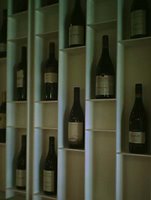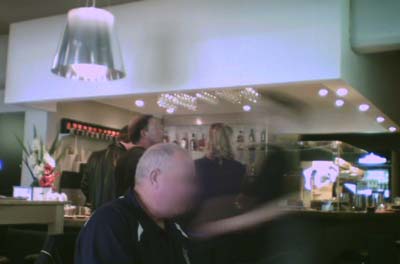
Since
my last set of Martini reviews back in September, I've tried Martinis at another eleven establishments, taking the total so far to 67. Since I only have six more bars to tick off to complete
my Herculean task, and many of those seem distinctly non-Martini-worthy (such as
the current mystery bar - there are some new hints among the comments), this will probably be the penultimate Martini review of the year. A handful of new bars are likely to open soon, and perhaps I'll take on some of the bars I've visited but where I've yet to try a 'tini: otherwise I've nearly reached total coverage (not to mention total organ failure). But on with the reviews!
Bisque On Bolton: 8.5The drink was made out of sight, so I didn't see the ingredients, but I'd speculate that it was the good stuff. Served in a large glass with two giant stuffed olives, it exhibited the classic Martini nose of juniper, herbs and citrus. It had a strong, weighty mouthfeel and tasted of liquorice and citrus, tending gradually saltier as I approached the end of the drink. To round things off, the olives were delicious.
Bohdans: 5Everything about this place seems like a flashback to somewhere between 1975 and 1985, so the ingredients were predictably old school: Gordons gin and Martini vermouth. These were stirred briefly with ice, then strained into an unchilled glass and garnished with two olives … and two straws! It had a vague gin and lemonade nose, with a sweet, tepid, watery body and a hint of pepperiness on the finish.
Ernesto: 7.5This was generally a good Martini, though perhaps lacking a little in body (which I'll put down to the use of South gin). The single, giant olive was skewered off-axis, due to the presence of a pit, but the intensity of the olive flavour added an interesting dimension. With a little slick of brine on the surface, this bordered on being a Dirty Martini: it's a variation to which I'm not averse, though not what one expects by default.
The Lanes: 6.5My order provoked some excitement, bordering upon consternation, among the staff: this was the first Martini to have been ordered there. By the time they'd found someone who knew what one was, I'd given up being too fussy, and even pressed on with my Quixotic request when they revealed that they only had red vermouth. In any case, with the "rinse the glass and discard" approach to vermouth the amount of that ingredient was so small that I wouldn't have suspected the presence of Rosso if I hadn't seen it. In fact, given the bar standards of bowling alleys in the Wellington region, I'd have to say the result far exceeded the norm.
Logan Brown: 8.5This is an establishment that sets high expectations, and the presence of Junípero gin on the bar shelves confirmed that they are as serious about spirits as they are about food and wine. The enthusiastic barman stirred the gin with ice and a slug of Noilly Prat, then strained the drink into a refrigerated glass with two "free-range" olives. The bouquet was intense, with juniper and liquorice prevailing, and the richly unctuous body was let down only marginally by a slightly hot finish. Perhaps a little more stirring would have integrated the flavours more, but otherwise this met all expectations.
Mercure Willis Hotel: 8Never trust a hotel bar that, at cocktail hour, has a sign reading "for bar service please contact reception". That's generally a good maxim, but the presence of Tanqueray on the shelves encouraged more optimism than usual. When I asked for a Martini, the barmaid summoned the bar manager, who seemed more than happy to have a patron ask for something other than a lager or a white wine.
Things started to go downhill from there. The Tanqueray bottle was almost empty, and an extensive search of the back rooms revealed that it was the last. Bombay it was, then. And Martini vermouth. In a glass that had a furry underside after weeks gathering dust on the shelf.
But what's this? A crisp clear appearance, pleasantly restrained citrus aromas, a full, smooth body and a satisfyingly tart and balanced finish. In other words, pretty much a textbook Martini. Upon complementing the bar manager, I found that he had previously worked at
Hummingbird. It all goes to show that skill and care can triumph over mediocre ingredients and surroundings.
Mighty Mighty: 7.5These were probably not the best conditions for ordering a Martini, given the crush at the bar as the band started their set, but the seductive promise of Tanqueray and Noilly Prat lounging provocatively on the bar shelves was too much to ignore. Besides, how can one
not order a Martini in a place where the waiters sport waistcoats, turbans and muttonchop sideburns?
The bartender freely admitted never having made one before, but gamely pressed on under my instructions. I opted for a straightforward and traditional approach: chill the glass, pour five parts gin to one of vermouth into a mixing glass with ice, stir briefly and strain. It was garnished with a single free-range olive, but I wasn't going to quibble over the absence of a stick. The result was very pleasant and quaffable (though quaffing a Martini is neither decorous nor safe) without being outstanding, and I expect the results here would be better in more relaxed times.
Orchid Lounge: 6.5The drink was cold and clear, though with an oddly yellow-green tint, and served with two olives on a flat stick. The aroma was sweet and herbal, dominated by lemon and the distinctive smell of vermouth, and while the body was drier than the nose suggested, it finished off with a sweetish edge. As I suspected, it turns out it was made with sweet vermouth rather than dry, so despite being drinkable enough, doesn’t really qualify as a "Dry" Martini. At least they didn't kill it with lime juice as they did in their previous incarnation!
St Johns: 8Seated at a brand-new dark polished wood bar in a spacious Art Deco building, and spying Tanqueray Ten and Noilly Prat on the shelves, my expectations were understandably high. Opening nights are always a bit dicey, though, and in this case they were all out of olives. I went with a twist of lemon instead, and the result, while made with care and the best alcoholic ingredients, was dominated by the citrus flavour. I used to be a twist man, but now that I'm attuned to the savoury edge that olives bring, I find that a twist sweetens and overpowers the drink. They should be fully stocked with olives by now, so it may be time for a rematch.
Spice Island: 5As this establishment is decidedly more upmarket than its predecessor
Lumiere, I expected staff who knew how to make a Martini. Initial signs were good, as I was asked whether I preferred vodka or gin, shaken or stirred, twist or olives. The results were disappointing, however: a little on the tepid side, with a touch of cloudiness, and overpoweringly sweet. Later investigations revealed that sweet vermouth was again the culprit, and it had obviously been added in far too great a proportion.
The Grill at Duxton: 8While I didn't see it being made (we were in the restaurant area), I'd guess that good quality ingredients were involved, since the result was canonical. Crisp, clear and cold, with three olives in a large glass, its promising appearance was confirmed by a heady aroma of herbs and citrus and complemented by a rich, mellow body and clean finish. Precise and delicious, without being groundbreaking, it's exactly what one should expect of a hotel Martini.
 At the risk of pimping the Wellingtonista awards ad nauseum, I thought I'd just point out that you have only two hours before voting closes. In case you need an incentive to vote (as if T-shirts and salads weren't enough!), I'll be throwing one more prize into the pool: a (very very) limited edition booklet called Wellingtini: a guide for the thirsty. This gathers together all my Martini reviews into one handy dead-tree format, adds some never-before-seen recipes, and garnishes it all with some surprisingly sober reflections and a scholarly bibli(ous)ography.
At the risk of pimping the Wellingtonista awards ad nauseum, I thought I'd just point out that you have only two hours before voting closes. In case you need an incentive to vote (as if T-shirts and salads weren't enough!), I'll be throwing one more prize into the pool: a (very very) limited edition booklet called Wellingtini: a guide for the thirsty. This gathers together all my Martini reviews into one handy dead-tree format, adds some never-before-seen recipes, and garnishes it all with some surprisingly sober reflections and a scholarly bibli(ous)ography.



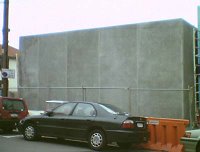
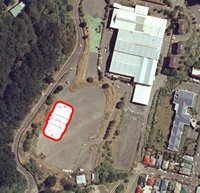
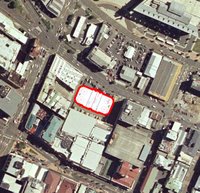
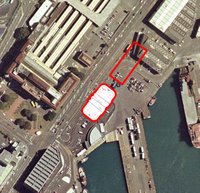

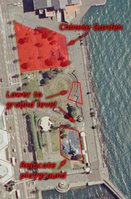
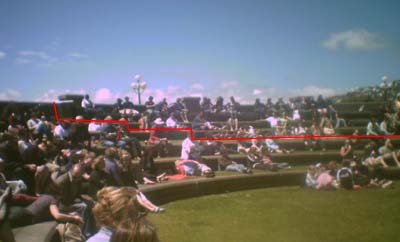 Together with removing the steps that block the Willeston St viewshaft, this would help give the feeling of actually being on the waterfront, and create some informal seating facing towards the water as well as away from it. It would reduce the capacity of the amphitheatre (by about 50 or so), but for bigger events some temporary seating could be installed above the northernmost terrace. For really big events ... there's always Waitangi Park.
Together with removing the steps that block the Willeston St viewshaft, this would help give the feeling of actually being on the waterfront, and create some informal seating facing towards the water as well as away from it. It would reduce the capacity of the amphitheatre (by about 50 or so), but for bigger events some temporary seating could be installed above the northernmost terrace. For really big events ... there's always Waitangi Park.
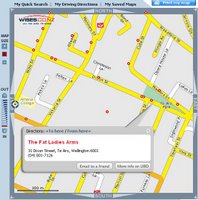

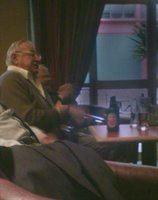

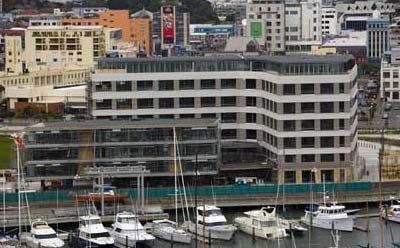 Wellington Waterfront have listed some of the food and other retail outlets that are confirmed so far:
Wellington Waterfront have listed some of the food and other retail outlets that are confirmed so far:



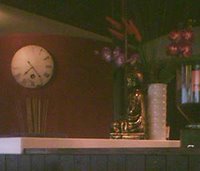

 Next door to
Next door to 